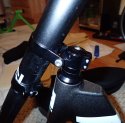Crank Arm length
When you buy a crankset, the typical crank arm lengths are 170mm, 172.5mm, and 175mm. Somehow the major drivetrain manufactures have determined that that 5mm range covers the cycling population. Nancy is 5'3''(160cm) and I am 6'(182cm) so I've always bought 170 for her and 175 for me without much further thought.
We live in North Carolina about a 4 hour drive from LarryOz but fortunately, only a few minutes from Larry's folks. So a Happy Birthday to Mom meant Larry came to town and brought his variable crank length crankset. Without using a power meter, using only perceived effort, Nancy tested different crank lengths and
really liked 130mm. That was the sweet spot. Shorter than that started feeling wrong. 40mm (1.57 inch) is a big change, but made it so her knee was less sharply bent and ready to generate power when the crank rotated around.
I don't have a photo of Nancy's knee angle with the 170 cranks, but here is one with the 130 setting. She felt the stroke was smooth and she was much more ready to provide power. After fitting, we went outside for a ride (putting platform pedals back on) and Nancy very much liked the feeling of shorter crank arms. So we'll build her a 130mm crankset and have ourselves an extended test.
You can read more with Larry's write up here:
http://cruzbike.com/forum/threads/fun-with-crank-lengths.8536/#post-110263
Showing the crankset replaced with Larry's variable length crankset.

Nancy's knees were in a much better position to apply power at 130mm.
































